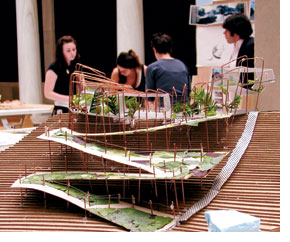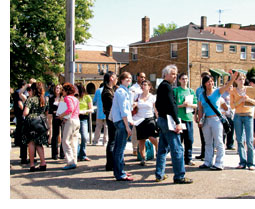Back
 Maggie
Matela, a 17-year-old Avonworth High School graduate, recently
faced a daunting challenge: designing both a kindergarten
and a public amphitheater on a Second Avenue site overlooking
the riverfront in Hazelwood. The assignment came as part
of an architectural learning forum held this summer at
Carnegie Museum of Art. Maggie
Matela, a 17-year-old Avonworth High School graduate, recently
faced a daunting challenge: designing both a kindergarten
and a public amphitheater on a Second Avenue site overlooking
the riverfront in Hazelwood. The assignment came as part
of an architectural learning forum held this summer at
Carnegie Museum of Art.
For Matela, the forum—called
a “charette,” or
a design brainstorming session—marked a chance to
sample the design experience from beginning to end. “I
really liked the charette,” says Matela, who will
begin studying industrial design at Pratt Institute in
Brooklyn this fall. “It proved useful seeing how
professional people work and how the thought processes
evolve.”
For Museum of Art staff, the charette opened
a new door on how to help museum visitors shape their experiences
when they visit. The museum is not alone, however, in its
strong desire to have its audiences take ownership of their
visits. The Andy Warhol Museum, City Theater, The Pittsburgh
Ballet and The Pittsburgh Symphony are all just as eager
to achieve the same goal.
 Enter The Heinz Endowments Arts
Experience Initiative. The initiative has given each of
the five institutions
two-year, $50,000 grants to experiment with ways to get
cultural arts participants more involved in the exhibitions
and events they attend. The ultimate goal: to change how
they view their “customers” and to deeply engage
their audiences in the subject matter. Enter The Heinz Endowments Arts
Experience Initiative. The initiative has given each of
the five institutions
two-year, $50,000 grants to experiment with ways to get
cultural arts participants more involved in the exhibitions
and events they attend. The ultimate goal: to change how
they view their “customers” and to deeply engage
their audiences in the subject matter.
Janet Sarbaugh, director
of The Heinz Endowments’ Arts & Culture
Program, says, “Our planning process led us to believe
we should be supporting projects that encourage cultural
audiences to be more actively involved in the venue they
are attending. So we set aside some funds to experiment
with like-minded institutions interested in delving into
this concept.”
“
The initiative’s funded projects are trying to get
away from the ‘talking head’ kind of thing
and much more into the experiential process. But it takes
money, time, and the willingness to fail,” says Lynne
Conner, a professor of theater and history at the University
of Pittsburgh, who is also an expert on audience engagement
and the principal investigator for the initiative.
The
Museum of Art’s charette, which focused on the
exhibition Michael Maltzan: Alternate Ground,
brought together five teams of local high school and college
students as
well as professional architects from Pittsburgh and Los
Angeles. Each team was given a local urban site and asked
to consider how they would incorporate two unrelated types
of buildings on it. Their work sessions took place in the
Museum of Art’s Hall of Sculpture, where other museum
visitors could view their sketches and models and hear
the students’ final presentations. At The Andy Warhol
Museum, the staff is using their funding to revise the
museum’s signage and transform several
corridors to create an easier-to-navigate experience as
well as one that encourages more discussion of exhibitions.
For example, during the exhibition Andy Warhol’s
Time Capsules, one of the hallways held a photocopier that
visitors could use to “transform their everyday” just
like Warhol did with his Time Capsules collection. Visitors
could photocopy items in their purses and pockets and display
them in the museum beside Warhol’s collectibles.
City
Theater is using its grant money to fund and market discussion
panels called “Text and Context” sessions,
writing workshops, and lectures related to its plays, says
Lisa Remby, the theater’s marketing director. Recently,
the theater had a panel of Frank Lloyd Wright fellows speak
about the famous architect in connection with the theater’s
production Work Song: Three Views of Frank Lloyd Wright.
“The ‘Text and Context’ sessions help
us enhance the experience of coming to the play. The more
you know
about the author and background, the more you get out of
the play itself,” Remby says.
For its part, the Pittsburgh
Symphony has experimented with several projects, the most
controversial being setting
up two screens that project written messages during concert
downtimes. A screen might give context about the show’s
second half or a particular song before it begins, explains
Robert Moir, the symphony’s vice president of artistic
planning. There are also regular “talk-back sessions” when
members of the audience can stay afterward to talk about
the music. “We hope to provide a forum where audience
members can extend the concert experience for another hour,” Moir
says.
At the Pittsburgh Ballet, the staff is using The Heinz
Endowments funds to enhance some of its existing programs
and create others. Ballet patrons can look behind the scenes
with the “Family Point” program prior to a
Saturday afternoon matinee. And “Talks with Terry” allow
ticket holders to come before a show to talk about the
production with Terrence Orr, the Ballet’s artistic
director, while dancers rehearse on stage behind him.
In
the case of the Museum of Art’s charette, it was
a true experiment that was in marked contrast to the all-too-common
breeze through an art exhibition. According to Karen Knutson,
one of the evaluators for the initiative and the associate
director of arts and humanities at UPCLOSE, the University
of Pittsburgh’s Center for Learning in Out of School
Environments, “Participants got an incredibly rich,
once-in-a-lifetime experience, and they brought their families
on board, too. It really set the ‘gold standard’ for
museum audiences making an exhibition their own.”
Back
| Top |